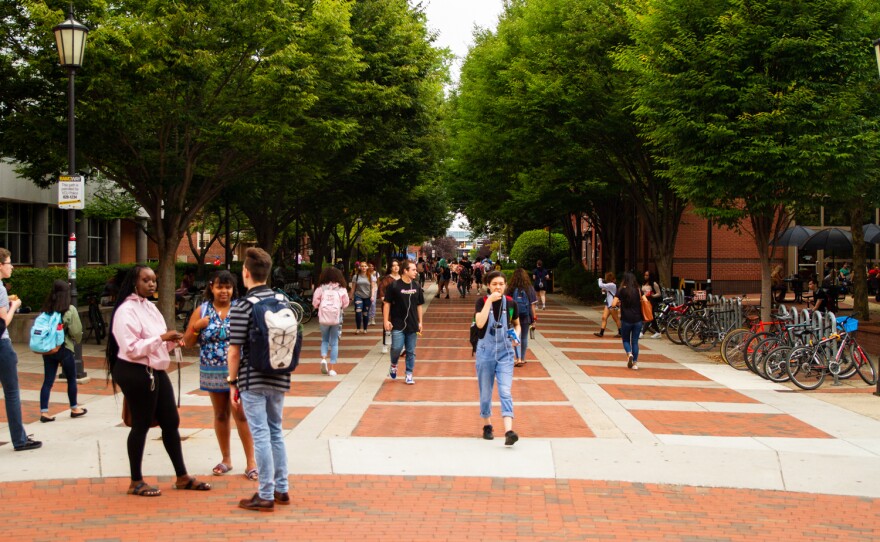Undergraduate students at Virginia’s public universities who don’t get any help from their families to pay for school don’t always get the most money from state and university aid awards.
That’s according to a new report from JLARC, the state legislature’s research arm. These students accounted for about half of the $162 million in unmet financial need in the 2020-’21 school year after all federal, state and institutional aid awards were applied.
And even though Virginia lawmakers recently invested a large amount into the state’s financial aid programs, JLARC associate director Tracey Smith said it’s important to note that a large amount of unmet student need still exists.
“As you see tuition and fees and other costs of higher education increasing – even though that was a tremendous infusion of funding – it's likely that the trend is going to be that students need even more in years to come,” Smith said.
Consolidating Virginia’s state aid programs
JLARC recommended consolidating the state’s two primary financial aid award programs — Virginia Guaranteed Assistance Program and the Virginia Commonwealth Award — and also recommended nixing some of the requirements. For example, VGAP currently requires students to remain enrolled as full-time students to secure and keep this award.
“It was a pretty significant barrier, particularly for students with large amounts of financial need,” said Lauren Axselle, JLARC legislative analyst and project leader on the financial aid study.
Axselle said removing the full-time requirement in favor of a six-credit-hour threshold, for example, would go a long way toward improving access to the grant because of Virginia’s large part-time student population. According to the report, about one in four — or more than 24,000 — students enrolled at the state's universities during the 2020-21 school year were part-time.
The State Council for Higher Education in Virginia agrees with JLARC that consolidating state grant programs makes sense, said Lee Andes, the organization’s associate director for financial aid.
“It’s more complicated than it needs to be,” Andes said, noting that JLARC already recommended eliminating the VGAP program and just using the Commonwealth Award program, while incorporating some elements of VGAP.
Andes said that’s because the Virginia Commonwealth Award has fewer requirements. It requires undergraduate students to live in Virginia, to enroll in classes at least half-time and to have a demonstrated financial need. To keep awards, students must maintain satisfactory academic progress.
On the other hand, he said, VGAP was started as a way to “create an incentive for students to progress to completion,” with larger awards the further along a student gets in their education.
Andes said if the two state aid programs were combined, SCHEV could still “try to build in an incentive for students to maintain that four-year completion path.”
For example, he said, eligible students would get the baseline Commonwealth Award.
“And then as they advanced a class level, there’d be a separate bonus award,” Andes said. “So, rather than something they’re trying to not lose, it’s actually something they would earn.”
Ensuring state aid goes to students with the most need
While SCHEV requires institutions to grant state aid awards to the students with the highest level of need, the JLARC report found that some higher-income students are also receiving the aid.
For example, a number of schools including VCU, George Mason, Longwood and Christopher Newport universities recently awarded a quarter of all state aid to students with a moderate or high ability to pay for tuition and fees.
"We are working with JLARC so that we better understand their analysis. VCU does all it can to remove financial barriers that prevent students from earning a degree," a VCU spokesperson said in an email. "When all financial aid sources are considered within the aid packages of students; minimal, moderate or high ability to pay for college families may have similar remaining financial needs."
To ensure state aid goes to the students with the highest level of demonstrated financial need first, JLARC recommended restricting awards by either setting an income cap for the awards, or by requiring all public colleges to use the same formula when making awards.
Axselle said that, for example, SCHEV could determine a certain EFC — or expected family contribution — level as a cutoff point for state awards to ensure students with a lower EFC get the money.
Or, Axselle said, the state could implement a statewide awarding schedule which she said would “remove institutions’ discretion to determine which students receive state grants and what size the state grants are.”
Andes, with SCHEV, said: “I don’t think it's unreasonable to say that for our base-level state access grant or affordability grant, that we preserve those for low and middle-income students.”
And while universities do have more discretion over how institutional aid is doled out, Axselle said, “this is something that institutions could look at, to really see how much aid they are awarding is merit-based versus need-based, and see if there are further dollars that can go to students based on need.”
JLARC found that by prioritizing merit-based awards, a number of public universities award institutional aid to students with comparatively less need.
Editor's note: This story was updated Nov. 9 at 7:29 p.m. to include comment from VCU.
Correction: Statistics regarding financial aid awards at VCU have been updated due to inaccurate information initially provided by JLARC. A graphic also has been updated.





